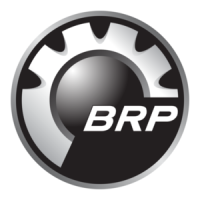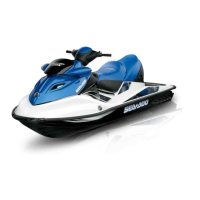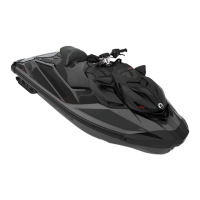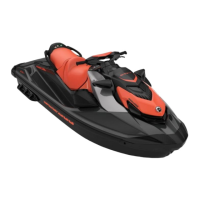
Do you have a question about the BRP Sea-Doo GTX PRO 130 and is the answer not in the manual?
| Horsepower | 130 HP |
|---|---|
| Seating Capacity | 3 persons |
| Hull Type | ST3 Hull |
| Displacement | 1630 cc |
| Length | 345.1 cm |
| Width | 125.5 cm |
| Fuel Capacity | 60 L |
| Braking System | iBR (Intelligent Brake & Reverse) |
| Engine Type | Rotax 1630 ACE |
| Dry Weight | 758 lb (344 kg) |
| Storage Capacity | 42.8 US gal / 162 L |
| Height | 44.8" / 113.8 cm |
Overview of the guide's content covering safety, usage, and maintenance.
Critical safety warning about reading the guide thoroughly before operation.
Key guidelines and rules for safe personal watercraft operation.
Important safety information to review before operating the watercraft.
Explanation of safety symbols and words used in the manual.
Purpose and guidelines for using the operator's guide.
Requirements for operator age, qualifications, and physical condition.
Warning against operating under the influence of drugs or alcohol.
Recommendation to take a boating safety course.
Importance of checking and following local boating regulations.
Mandatory safety equipment required for all riders.
Discussion on the advantages and disadvantages of wearing a helmet.
List of essential safety equipment required to be aboard.
Explanation of the watercraft's jet propulsion system.
How the handlebar controls the watercraft's direction.
Function and importance of the safety lanyard for engine cutoff.
Information on the iBR braking and reverse system.
Details on the speed-limiting learning key feature.
Guidelines for securely carrying items and storage.
Advice on adding accessories and avoiding unauthorized modifications.
Safe practices and instructions for riding with passengers.
Strategies and awareness tips to prevent collisions.
Recommended riding conduct and maintaining control.
Considerations and risks associated with high-speed operation.
Instructions on how to safely reboard the watercraft from the water.
Warnings about dangerous moving components and keeping clear.
Importance of understanding water conditions, planning routes, and weather.
Guidelines for safe navigation and respecting waterways.
Information stating the watercraft is not designed for night operation.
Risks and prevention measures for carbon monoxide poisoning.
Safety precautions related to fuel handling and fire hazards.
Warning about potential burns from hot engine components.
Guidelines and safety procedures for towing activities.
Procedures and safety measures after a skier or rider falls.
Safety instructions and precautions for using tow ropes.
Criteria for selecting a safe area to practice watercraft maneuvers.
Specific exercises to improve handling and control skills.
Step-by-step instructions for safely refueling the watercraft.
Specifications for the correct type of fuel and octane rating.
Information regarding the importance and location of safety labels.
Details and interpretation of the general warning label.
Information provided by the notice label in the glove box.
Notice label detailing the recommended fuel type.
Warning label associated with the fueling procedure.
Warning label concerning battery handling and charging.
Notice label regarding the air intake silencer's function.
Warning label against opening hot components.
Notice label for checking the engine oil level.
Caution label regarding hot engine components.
Warning label illustrating prohibition of sitting on certain parts.
Pictogram and text regarding recommended rider attire.
Warning pictogram against putting fuel in wrong locations.
Warning label detailing safe re-boarding procedures.
Caution label regarding the risk of tipping over.
Label indicating parts not to be used for boarding.
Warning label concerning the iBR gate mechanism.
Pre-launch checklist for ensuring safe operation.
Importance of securing bilge drain plugs before launching.
Procedure for ensuring the fuel tank is properly filled.
Inspection steps for the engine compartment.
Procedure for checking the engine oil level.
Procedure for checking the engine coolant level.
Checking the operation and free movement of the steering system.
Checking the free and smooth operation of the throttle control.
Checking the free and smooth operation of the iBR lever.
Ensuring all compartments, platform, and seat are securely latched.
Testing the engine cut-off switch and start/stop button functions.
Checks to perform after launching the watercraft.
Procedures for after use, including cleaning for invasive species.
Maintenance requirements specific to salt or dirty water usage.
Schedule of regular maintenance tasks for the engine.
Function of the handlebar for steering and direction control.
How the throttle lever controls engine speed and watercraft acceleration.
Functions of the iBR lever for braking, reverse, and neutral.
Operation of the engine cut-off switch with the tether cord.
Operation of the engine start and stop button.
Explanation of the D.E.S.S. key system for engine starting.
Function of the INFO button for navigating menus and settings.
How to select different operating modes like Sport or ECO.
Function of the TRIP button for accessing trip meter and clock.
Location and use of the front storage compartment.
Description of the glove box for personal items.
Details about the small watertight compartment for personal articles.
Procedure for correctly installing the watercraft seat.
Procedure for correctly removing the watercraft seat.
Location and use of handholds for passenger safety.
Description of the boarding platform at the rear deck.
Use of mooring cleats for docking and towing.
Information about the boarding ladder for water access.
Use of eyelets for mooring and securing during transport.
Importance and procedure for securing bilge drain plugs.
Description of the multifunction gauge and its display elements.
Explanation of various indicator lights and warning messages.
Guidelines for operating the watercraft during its break-in period.
Methods and safety precautions for boarding the watercraft.
Step-by-step instructions for safely starting the engine.
Procedures for safely shutting off the engine.
How to steer and control the watercraft's direction.
Procedure for shifting the watercraft into neutral.
Procedure for shifting the watercraft into forward gear.
Procedure for shifting the watercraft into reverse.
Detailed explanation of the braking system operation and usage.
Precautions for operating in rough water or low visibility conditions.
Safe practices and body positioning for crossing wakes or waves.
Techniques for stopping and docking the watercraft safely.
Description of the standard Touring operating mode.
Description and activation of Sport mode for enhanced response.
Description of ECO mode for fuel efficiency.
Description of the Learning Key mode for speed limitation.
Procedure for cleaning the jet pump water intake and impeller.
Instructions for using the iBR override function.
Steps to take if the watercraft becomes capsized.
Procedure to follow if the watercraft is submerged.
Actions to take in case of a water-flooded engine.
Guidelines and precautions for towing the watercraft in water.
Maintenance requirements for using the watercraft in salt or dirty water.
Schedule of regular maintenance tasks for the engine and vehicle.
Procedures for removing and installing the engine service cover.
Information on recommended engine oil type and level checking.
Information on recommended engine coolant and level checking.
Procedure for replacing the engine coolant.
Access and procedures for ignition coils.
Procedures for removing, installing, and checking spark plugs.
Information and flushing procedures for the exhaust system.
Inspection of the ride plate and water intake grate for damage.
Inspection and replacement of sacrificial anodes.
Location, description, and replacement of fuses.
Steps for caring for the watercraft after operation.
Procedures for repairing and cleaning the body and hull.
General procedures for storing the watercraft.
Instructions for maintaining the battery during storage.
Steps for cleaning the engine compartment before storage.
Applying anticorrosion treatment to protect components.
Location and format of the Hull Identification Number (HIN).
Location of the Engine Identification Number (EIN).
Information on the engine manufacturer identification label.
Explanation of the emission control hang tag and star rating.
Details of the emission control label and its meaning.
Information on the EPA compliance label for emissions.
Details of the regulation exemption label.
Manufacturer's responsibilities regarding engine emissions compliance.
Dealer's responsibilities for maintaining emissions compliance.
Owner's responsibilities for maintaining engine emissions standards.
Technical specifications for the watercraft's engine.
Technical specifications for the watercraft.
General guidelines for diagnosing and resolving common issues.
Understanding the watercraft's monitoring system and fault indicators.
Defines what the limited warranty covers in the USA and Canada.
Details limitations and disclaimers of liability for the warranty.
Lists items and conditions not covered by the warranty.
Specifies the duration of the limited warranty coverage.
Lists the conditions that must be met for warranty coverage.
Steps a customer must take to obtain warranty service.
Details BRP's obligations for warranty repairs or replacements.
Policy regarding the transfer of warranty to a new owner.
Information on how to contact BRP for consumer assistance.
Specifies the duration of the emission-related warranty.
Lists components covered under the emission warranty.
Details limitations on emission-related warranty claims.
Owner's rights and responsibilities for the evaporative emissions warranty.
Manufacturer's coverage details for the evaporative emissions system.
Owner's responsibilities regarding maintenance for emissions warranty.
Owner's rights and obligations for CA/NY emissions warranty.
Manufacturer's limited warranty coverage for CA/NY emissions.
List of emission-related parts covered under the warranty.
Defines the scope of the international limited warranty.
Details limitations of liability for the international warranty.
Lists items excluded from the international limited warranty.
Specifies the coverage period for the international warranty.
Conditions required to obtain warranty coverage internationally.
Steps for obtaining warranty service internationally.
Details BRP's obligations under the international warranty.
Defines the scope of the warranty for EEA, CIS, and Turkey.
Details limitations of liability for the regional warranty.
Lists exclusions from the warranty for specific regions.
Specifies the coverage period for the regional warranty.
Conditions required for warranty coverage in specific regions.
Steps for obtaining warranty service in specific regions.
Details BRP's obligations under the regional warranty.












